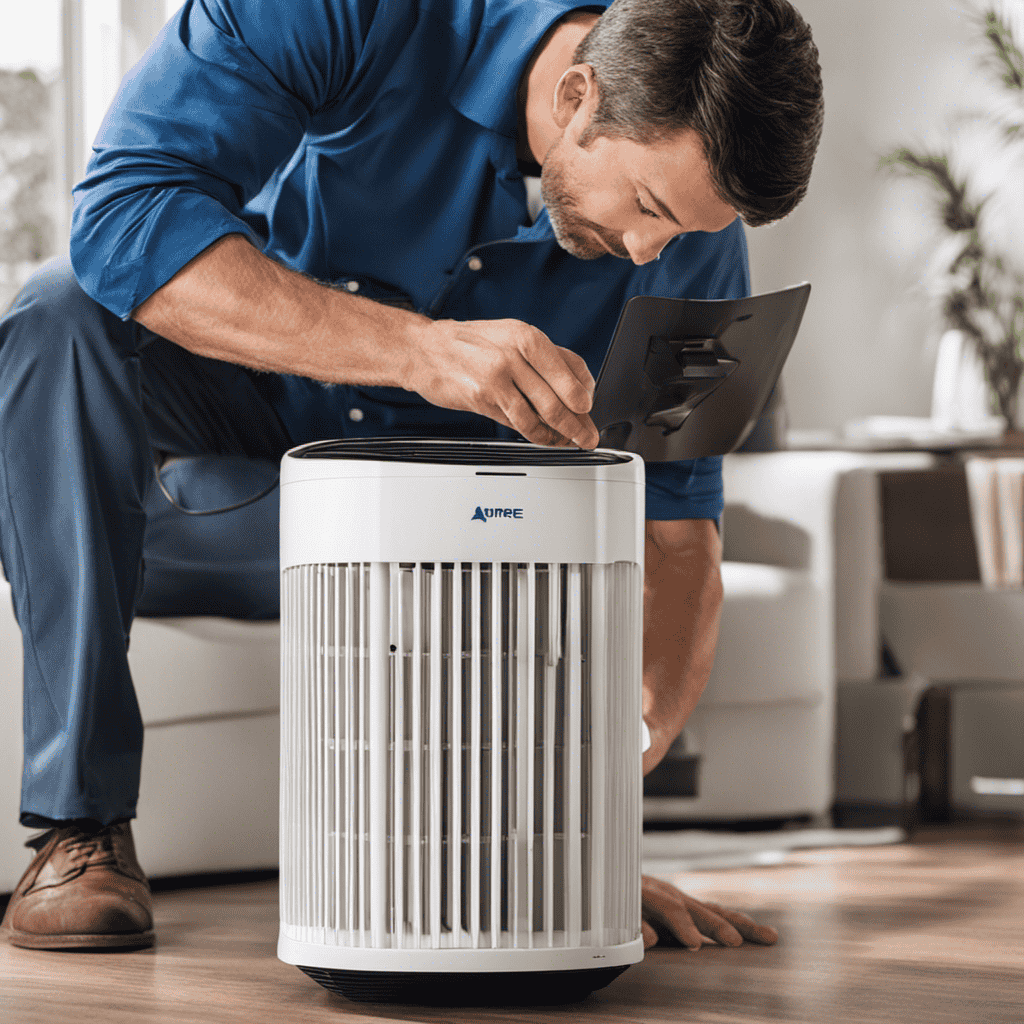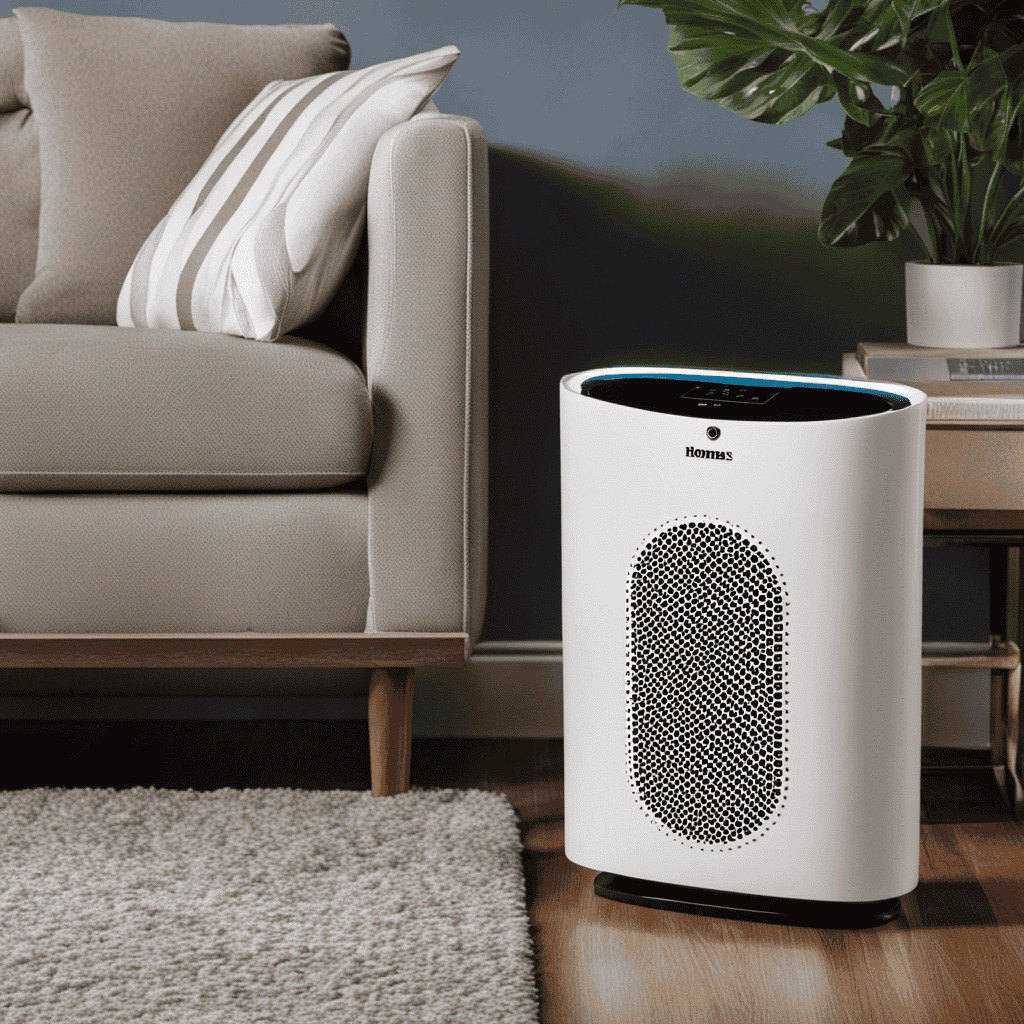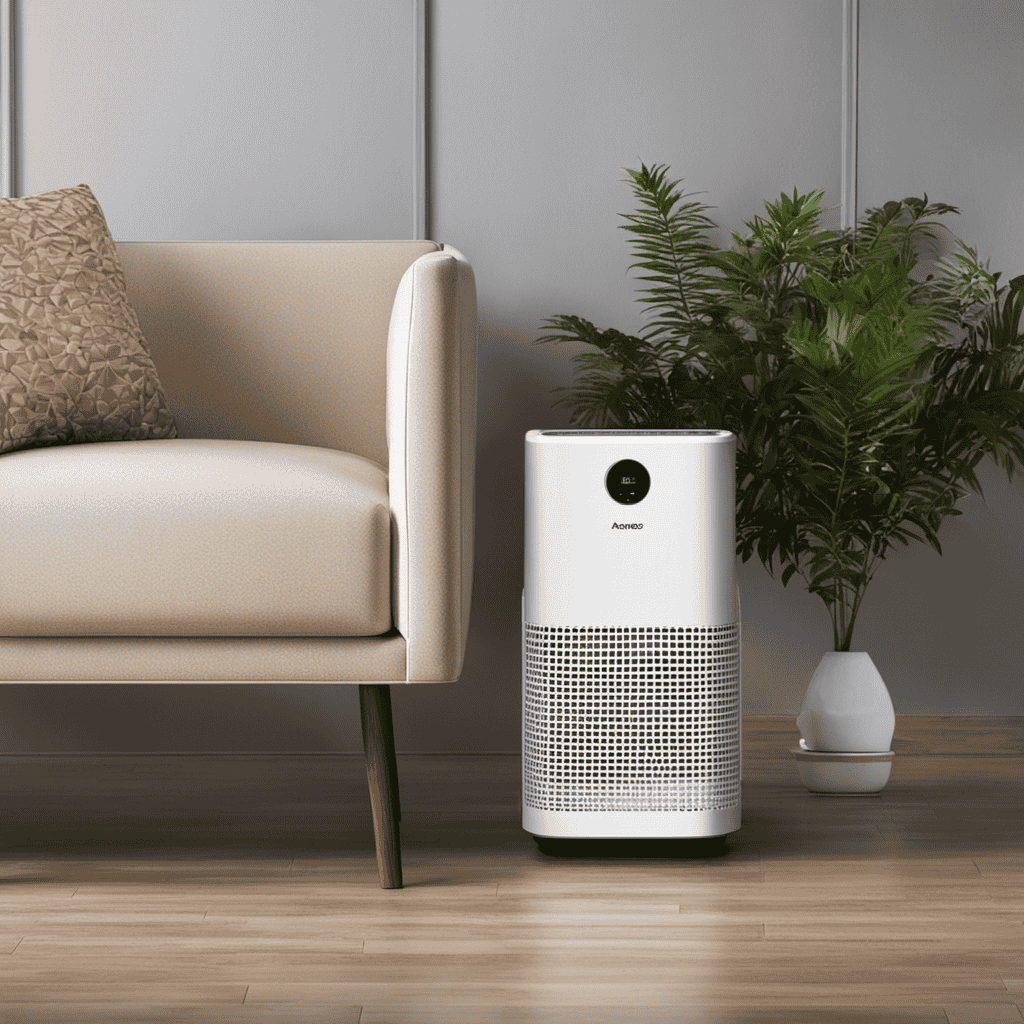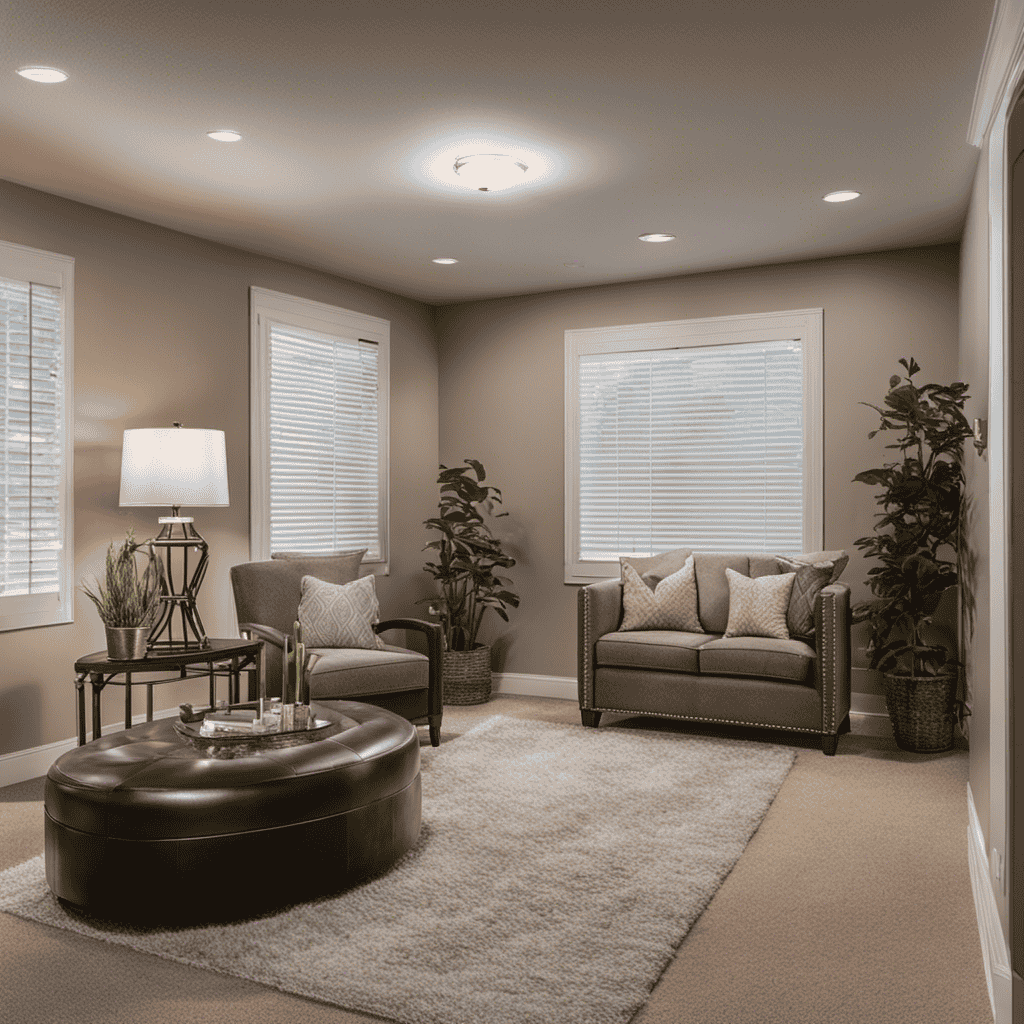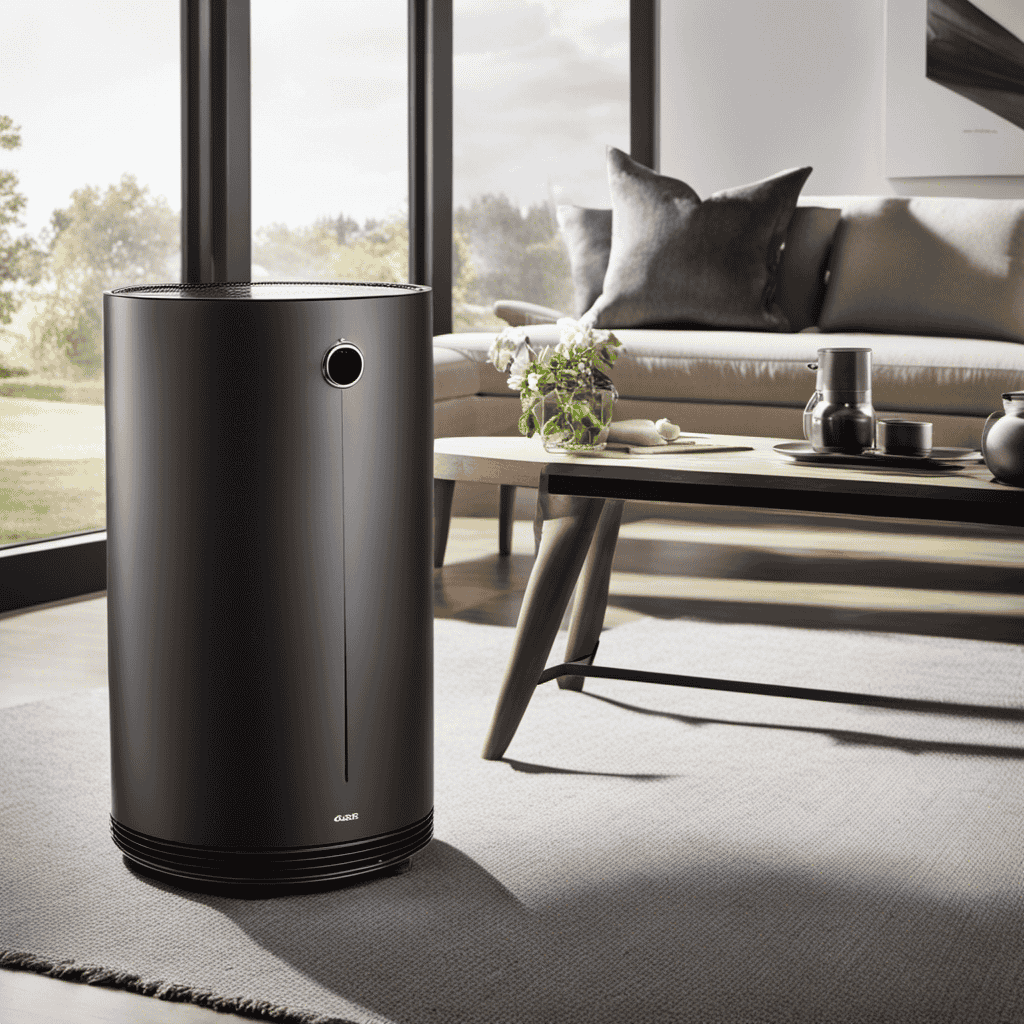I have found a simple yet important task that can significantly enhance the air quality in your household – replacing your air purifier filter.
In this article, I will guide you through the process step by step, ensuring that you have all the information you need to successfully replace your filter.
Understanding the different types of filters, choosing the right replacement, and proper disposal methods are just a few topics I’ll cover.
Get ready to breathe cleaner air and enjoy a healthier living environment.
Key Takeaways
- Regularly changing the air purifier filter maintains the effectiveness of the air purifier in cleaning the air.
- Different types of air purifier filters should be considered based on efficiency, lifespan, and specific needs.
- Proper disposal of the old filter and installation of a new filter are crucial.
- Choosing the right replacement filter involves consulting the manufacturer’s website for compatibility, considering the filter type and size, and following the manufacturer’s recommendations for lifespan.
Why You Should Change Your Air Purifier Filter Regularly
You should change your air purifier filter regularly because it helps to maintain the effectiveness of the purifier in cleaning the air in your home.
The filter plays a crucial role in capturing and removing airborne contaminants, such as dust, pollen, pet dander, and mold spores. Over time, the filter becomes clogged with these particles, reducing its ability to purify the air efficiently.
By changing the filter regularly, you ensure that the purifier continues to operate at its optimal level, providing you with clean and fresh air.
Some air purifiers have alternative filter monitoring systems that alert you when it’s time to replace the filter, making the process even more convenient.
If you encounter any issues or have questions about changing the filter, consult the troubleshooting guide provided by the manufacturer.
Understanding the different types of air purifier filters will further enhance your knowledge and enable you to make informed decisions about choosing the right filter for your needs.
Understanding the Different Types of Air Purifier Filters
Understanding the various types of air purifier filters can help you choose the most suitable one for your needs. When it comes to choosing the right filter, two important factors to consider are the filter size and the filter material. Let’s take a closer look at these factors in the table below:
| Filter Size | Filter Materials |
|---|---|
| Small | HEPA |
| Medium | Carbon |
| Large | Ionizer |
| Extra-Large | UV-C |
Choosing the right filter size is crucial to ensure that it fits properly in your air purifier. It’s important to check the specifications of your air purifier to determine the correct filter size. When comparing filter materials, consider factors such as the efficiency in removing pollutants, the lifespan of the filter, and any specific needs you may have, such as allergies or odors. By understanding the different types of air purifier filters and considering these factors, you can make an informed decision when selecting the most suitable filter for your air purifier.
Now that you understand the different types of air purifier filters, let’s move on to the next section where we will provide a step-by-step guide to removing the old filter.
Step-by-Step Guide to Removing the Old Filter
When it comes to maintaining the efficiency of your air purifier, proper filter disposal and installing a new filter are key steps.
First, it’s important to dispose of the old filter correctly to prevent any potential contaminants from being released back into the air.
Next, installing a new filter involves following a step-by-step process to ensure a proper fit and optimal performance.
Proper Filter Disposal
To properly dispose of the filter, it’s important to follow the manufacturer’s guidelines. Here are the steps to ensure proper filter disposal:
- Check the manufacturer’s instructions for specific disposal instructions.
- If the filter is recyclable, remove it from the air purifier and place it in the appropriate recycling bin.
- Separate any plastic components from the filter, as they may need to be recycled separately.
- Clean the filter before recycling if necessary, following the manufacturer’s recommendations.
If the filter is not recyclable, wrap it in a plastic bag and seal it tightly to prevent any dust or contaminants from escaping. Dispose of the bagged filter in the regular trash bin.
Make sure to properly wash your hands after handling the used filter to avoid any potential contamination.
Proper filter maintenance and environmentally friendly filter options are essential in ensuring clean air and reducing waste. Follow these guidelines to dispose of your air purifier filters responsibly.
Installing a New Filter
Once you’ve bought a new filter, it’s as simple as removing the old one and replacing it with the new one. Proper filter installation is crucial to ensure the optimal performance of your air purifier.
Begin by turning off the power and unplugging the unit. Locate the filter compartment, usually at the back or side of the purifier. Open the compartment and carefully remove the old filter, taking note of its orientation and how it fits in.
Now, take the new filter and insert it in the same position as the old one. Ensure that it is securely in place and the compartment is properly closed.
How to Choose the Right Replacement Filter for Your Air Purifier
If you’re unsure about which replacement filter is compatible with your air purifier, consult the manufacturer’s website for specific model recommendations. When choosing filters for your air purifier, there are a few factors to consider. Here are some maintenance tips to help you choose the right replacement filter:
-
Filter Type:
-
HEPA filters: These are highly effective at capturing small particles like dust, pollen, and pet dander.
-
Activated carbon filters: These are great for removing odors and chemicals from the air.
-
Filter Size:
-
Make sure to measure the existing filter or refer to the air purifier’s manual to find the correct size.
-
Using the wrong size filter can reduce the purifier’s efficiency.
-
Filter Lifespan:
-
Check the manufacturer’s recommendations for how often the filter needs to be replaced.
-
Regularly replacing the filter ensures optimal performance and clean air in your home.
Tips for Properly Cleaning the Air Purifier Housing
Make sure you regularly wipe down the housing of your air purifier to remove dust and dirt buildup. Cleaning the air purifier housing is an essential part of maintenance to ensure optimal performance.
To clean the housing, first, unplug the unit and remove the filter. Use a soft, lint-free cloth dampened with water or a mild cleaning solution to wipe the exterior surfaces. Take extra care around any buttons or displays, ensuring not to get them wet. Avoid using abrasive cleaners or harsh chemicals as they can damage the housing.
Once you have wiped down the housing, allow it to dry completely before reassembling the unit. Proper cleaning techniques like this will help prolong the life of your air purifier and ensure it continues to purify the air effectively.
Now, let’s move on to the importance of checking for dust and debris in the filter compartment.
The Importance of Checking for Dust and Debris in the Filter Compartment
To ensure optimal performance, regularly check the filter compartment for any dust or debris that may have accumulated. Maintaining clean filters is crucial for the efficient operation of your air purifier. Here are a few reasons why checking filter maintenance is important:
- Dust and debris buildup in the filter compartment can obstruct airflow, reducing the purifier’s effectiveness.
- Accumulated particles can clog the filter, decreasing its ability to capture pollutants from the air.
- A dirty filter can release trapped contaminants back into the room, compromising the air quality.
By routinely inspecting and cleaning the filter compartment, you can ensure that your air purifier functions at its best, providing you with clean and fresh air.
Now that we understand the significance of filter maintenance, let’s explore the common signs that indicate it’s time to change the filter.
Common Signs That Indicate It’s Time to Change the Filter
When it comes to maintaining optimal performance in an air purifier, understanding the filter replacement frequency is crucial.
By regularly replacing the filter, you can ensure that your air purifier continues to effectively remove contaminants from the air.
Additionally, knowing the warning signs of a clogged filter can help you identify when it’s time for a replacement, preventing any decline in air quality.
Filter Replacement Frequency
The filter’s replacement frequency depends on how often you use the air purifier. Regular air purifier filter maintenance is essential to keep your indoor air clean and fresh.
Here are some benefits of regular filter changes:
-
Improved Air Quality:
A clean filter ensures that the air purifier can effectively remove pollutants such as dust, pollen, and pet dander from the air, resulting in improved indoor air quality. Regular filter changes prevent the accumulation of debris on the filter, allowing it to maintain optimal performance. -
Extended Lifespan of the Air Purifier:
By regularly replacing the filter, you can prevent clogging and strain on the air purifier’s motor, which can extend its lifespan. A well-maintained air purifier will continue to effectively clean the air in your space, providing you with clean and fresh air for a longer period.
Remember to consult your air purifier’s user manual for specific guidelines on filter replacement frequency based on your usage and the type of filter used.
Warning Signs of Clogged Filter?
If you notice reduced airflow and a decrease in the air purifier’s effectiveness, it may be a sign of a clogged filter. Neglecting filter maintenance can have serious consequences for both your health and the efficiency of your air purifier. When a filter becomes clogged, it is unable to effectively trap and remove pollutants from the air. This means that harmful particles such as allergens, dust, and pet dander are not being filtered out properly, leading to decreased indoor air quality. Additionally, a clogged filter can cause strain on the motor of the air purifier, potentially leading to overheating and reduced lifespan of the device. Regularly cleaning or replacing the filter is crucial to ensure optimal performance and to avoid the dangers of neglecting clogged filters.
| Dangers of Neglecting Clogged Filters | Consequences of Ignoring Filter Maintenance |
|---|---|
| Decreased indoor air quality | Strain on air purifier’s motor |
| Allergens and pollutants remain in air | Reduced effectiveness of air purifier |
| Potential overheating of device | Shortened lifespan of air purifier |
How Often Should You Change Your Air Purifier Filter
You should consider how often you need to change your air purifier filter. The filter replacement frequency depends on several factors such as the type of air purifier, the level of air pollution, and the manufacturer’s recommendations.
Here are a few signs that indicate a clogged filter and the need for replacement:
-
Decreased airflow: If you notice that the air purifier is not circulating air as efficiently as before, it could be a sign of a clogged filter.
-
Increased dust accumulation: If you see more dust settling on surfaces despite regular cleaning, it may indicate a clogged filter.
-
Strong odors: If the air purifier fails to eliminate unpleasant odors, it might be due to a clogged filter.
To ensure optimal performance, it is recommended to consult the user manual or the manufacturer’s guidelines to determine the appropriate filter replacement frequency for your specific air purifier model.
What to Do If Your Air Purifier Doesn’t Have a Filter Replacement Indicator
When it comes to air purifiers, having a filter replacement indicator is essential for ensuring optimal performance.
However, if your air purifier doesn’t have this feature, there are still options available.
One option is to manually track the filter’s lifespan and replace it accordingly.
Another option is to explore alternative filter monitoring methods such as using a timer or monitoring the air quality in your home.
No Filter Indicator
To determine if it’s time to change your air purifier filter, simply check the no filter indicator. This handy feature will let you know when the filter needs to be replaced.
If you find yourself in a situation where your air purifier doesn’t have a filter replacement indicator, don’t worry. There are alternative solutions and troubleshooting tips you can try. Here’s how to navigate this situation:
-
Check the manual: Some air purifiers have a specific timeframe for filter replacement. Refer to the manual to see if there’s a recommended period for changing the filter.
-
Observe air quality: If you notice a decrease in air quality, such as increased dust or odors, it may be a sign that the filter needs to be replaced.
Manual Filter Replacement
If the no filter indicator is not available, refer to the manual for instructions on when to replace the air purifier’s filter. Proper filter maintenance is essential for the optimal performance of your air purifier. Regularly replacing the filter ensures that it effectively captures and removes pollutants from the air, improving indoor air quality.
The benefits of regular filter replacement are numerous. It helps to reduce allergens, such as dust, pollen, and pet dander, providing relief for those with allergies or asthma. It also eliminates odors caused by cooking, pets, or smoke, creating a fresh and clean environment.
Additionally, replacing the filter prevents the accumulation of harmful particles that can damage the air purifier’s motor or impede its airflow. Following the manufacturer’s guidelines for filter replacement is crucial to maintain the efficiency and longevity of your air purifier.
Alternative Filter Monitoring?
Regularly checking the status of your air purifier’s filter is important to ensure it is working effectively and maintaining good indoor air quality. However, there are alternative monitoring methods that can help you keep track of your filter’s lifespan.
Here are two options to consider:
-
Smart Air Purifiers: These innovative devices come with built-in sensors that monitor the filter’s condition and provide real-time data on its lifespan. This allows you to know exactly when it needs to be replaced, eliminating the need for manual checks.
-
Filter Replacement Reminders: Some air purifiers have programmable reminders that alert you when it’s time to change the filter. These reminders can be set based on the manufacturer’s recommended filter lifespan, ensuring you never forget to replace it on time.
The Benefits of Using High-Quality Air Purifier Filters
Using high-quality air purifier filters can greatly improve the air quality in your home. The benefits of clean air are numerous and essential for maintaining a healthy living environment.
Air purifier maintenance plays a crucial role in ensuring the efficiency and effectiveness of these filters. By regularly replacing your filters, you can remove pollutants such as dust, pollen, pet dander, and mold spores from the air, reducing the risk of respiratory issues and allergies.
High-quality filters are designed to capture even the smallest particles, providing cleaner and fresher air for you and your family to breathe. Additionally, clean air can enhance sleep quality, boost productivity, and improve overall well-being.
Investing in high-quality air purifier filters is a wise choice for maintaining a healthy home environment.
Potential Health Risks of Not Changing the Filter on Time
Not changing the filter on time can pose potential health risks. When an air purifier filter is not changed regularly, it becomes clogged with dust, allergens, and other pollutants. This can lead to decreased air quality in your home or office, which can have various consequences for your health.
Here are some potential risks and consequences:
-
Reduced respiratory function: A clogged filter can restrict the flow of clean air, making it harder to breathe and potentially exacerbating respiratory conditions such as asthma or allergies.
-
Increased allergy symptoms: The accumulation of allergens in a dirty filter can trigger allergic reactions, causing symptoms like sneezing, coughing, and itchy eyes.
-
Bacterial and mold growth: A neglected filter can become a breeding ground for harmful bacteria and mold, which can then be circulated throughout the space and cause respiratory infections or worsen existing conditions.
Regularly changing your air purifier filter is crucial for maintaining good indoor air quality and minimizing the potential health risks associated with poor filtration.
How to Extend the Lifespan of Your Air Purifier Filter
To extend the lifespan of your air purifier filter, it’s important to follow these maintenance tips. Regular cleaning of your air purifier filter will ensure optimal performance and help remove pollutants from the air in your home. Here are some steps to clean your air purifier filter:
- Turn off the air purifier and unplug it from the power source.
- Remove the filter from the air purifier according to the manufacturer’s instructions.
- Gently vacuum the filter to remove dust and debris.
- If the filter is washable, rinse it with water and mild soap. Let it dry completely before reinstalling.
- If the filter is not washable, replace it with a new one as recommended by the manufacturer.
By regularly cleaning and maintaining your air purifier filter, you can ensure that it continues to effectively remove allergens and pollutants from the air.
Additionally, using HEPA filters in your air purifier provides several benefits, including:
- Efficiently capturing particles as small as 0.3 microns.
- Trapping pet dander, pollen, dust mites, and other allergens.
- Helping to improve indoor air quality and reduce allergy symptoms.
Remember to always refer to the manufacturer’s instructions for specific cleaning and replacement guidelines for your air purifier filter.
Proper Disposal Methods for Used Air Purifier Filters
When it comes to proper disposal methods for used air purifier filters, it’s important to consider recycling options available for these filters.
Recycling not only helps reduce waste but also allows for the recovery of valuable materials.
Additionally, understanding the environmental impact of improper disposal is crucial in order to mitigate any potential harm caused by these filters ending up in landfills.
Recycling Options for Filters
You can easily recycle your air purifier filter by checking with local recycling centers or contacting the manufacturer for specific disposal instructions. Recycling options for filters are available to help reduce the environmental impact of disposal.
Here are two ways you can recycle your air purifier filter:
-
Local recycling centers:
-
Contact your local recycling center to inquire about their policies on recycling air purifier filters.
-
Some centers may accept filters for recycling, while others may have specific requirements or guidelines to follow.
-
Manufacturer recycling programs:
-
Reach out to the manufacturer of your air purifier to see if they have a recycling program in place.
-
Many manufacturers offer recycling options for filters, allowing you to return used filters to them for proper disposal or recycling.
Recycling your air purifier filter is an environmentally responsible way to dispose of it and prevent unnecessary waste.
Now, let’s explore the environmental impact of improper disposal methods.
Environmental Impact of Disposal
Consider the potential harm to the environment if air purifier filters are disposed of improperly. Proper disposal methods and recycling options are crucial to minimize the negative impact on our surroundings.
When it comes to disposal, it is important to follow local regulations and guidelines. Many air purifier filters are made of materials that can be recycled, such as paper, plastic, and metal. Recycling these filters ensures that valuable resources are not wasted and reduces the need for new raw materials.
Additionally, some manufacturers offer take-back programs or recycling initiatives for their filters. These programs provide an easy and responsible way to dispose of used filters.
Troubleshooting Guide for Common Air Purifier Filter Replacement Issues
If your air purifier filter replacement is causing issues, there are common troubleshooting steps you can take. Here are a few troubleshooting tips and maintenance tips that can help:
- Check the installation: Ensure that the filter is properly installed, with no gaps or loose connections.
- Clean the filter: Over time, the filter can accumulate dust and debris, reducing its effectiveness. Regularly clean the filter according to the manufacturer’s instructions.
- Use a soft brush or vacuum cleaner to remove surface dirt.
- If necessary, rinse the filter with water and let it dry completely before reinstalling.
By following these troubleshooting and maintenance tips, you can ensure that your air purifier filter replacement process goes smoothly and without any issues.
Now, let’s move on to frequently asked questions about changing air purifier filters.
Frequently Asked Questions About Changing Air Purifier Filters
Here’s a list of frequently asked questions about replacing air purifier filters:
| Question | Answer |
|---|---|
| How often should I replace my air filter? | It is recommended to replace your air purifier filter every 6 to 12 months, depending on the manufacturer’s instructions and the air quality in your home. Regular filter replacement is essential for maintaining optimal air purifier performance. |
| Can I clean and reuse my air filter? | No, most air purifier filters are not designed to be cleaned and reused. Cleaning them may damage the filter and reduce its effectiveness. It is best to replace the filter with a new one according to the manufacturer’s recommendations. |
| Are all air purifier filters the same? | No, air purifier filters vary depending on the type and model of the purifier. Common types include HEPA filters, activated carbon filters, and pre-filters. It is important to use the correct filter for your specific air purifier to ensure proper filtration. |
Maintaining air purifier filters is crucial for ensuring clean and healthy indoor air. However, there are some common misconceptions about changing air purifier filters. One such misconception is that filters can be cleaned and reused. While this may seem like a cost-saving measure, it can actually reduce the effectiveness of the filter and compromise its ability to remove impurities from the air. Another misconception is that all air purifier filters are the same. Different air purifiers require different types of filters, so it is important to use the correct filter for your specific model. By understanding the importance of regular filter replacement and using the right filter, you can maximize the performance of your air purifier and maintain a healthier indoor environment.
Frequently Asked Questions
Can I Reuse or Clean My Air Purifier Filter Instead of Replacing It?
No, I cannot reuse or clean my air purifier filter instead of replacing it. Reusing filters can compromise their efficiency, and cleaning may not fully remove contaminants. It’s best to follow manufacturer guidelines and replace the filter regularly for optimal performance.
How Do I Know if the Replacement Filter I Bought Is Compatible With My Air Purifier Model?
To find the right air purifier filter, I check the compatibility with my model. It’s important to ensure the replacement filter is compatible to ensure optimal performance and clean air in my home.
Is It Necessary to Wear Protective Gloves or a Mask While Handling the Old Air Purifier Filter?
I should wear protective gloves and a mask when handling the old air purifier filter. It is important to take precautions to avoid any potential contaminants or allergens that may be present in the filter.
What Should I Do if I Accidentally Damage the Filter Compartment While Removing the Old Filter?
If I accidentally damage the filter compartment while removing the old filter, I would carefully assess the extent of the damage. If necessary, I would consult the user manual or contact customer support for guidance on repairs or replacements.
Can I Recycle or Dispose of the Used Air Purifier Filter With Regular Household Waste?
Yes, you can recycle or dispose of the used air purifier filter with regular household waste. However, it is recommended to check for recycling options or proper disposal methods specific to your area to ensure environmentally friendly practices.
Conclusion
In conclusion, regularly changing your air purifier filter is essential for maintaining clean and healthy indoor air. By understanding the different types of filters and following a step-by-step guide, you can easily remove and replace the old filter.
Choosing the right replacement filter and properly cleaning the air purifier housing will ensure optimal performance. To extend the lifespan of your filter, follow maintenance tips and dispose of used filters correctly.
If you encounter any issues, refer to the troubleshooting guide. Remember, a breath of fresh air is just a filter change away.
